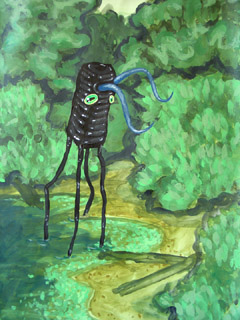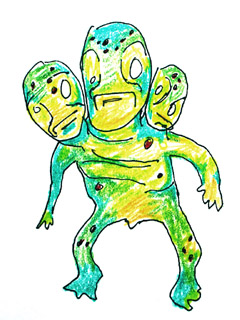
The Ichabod is found only in the deep swamps of Louisiana. Its diet consists solely of Polycephalic Forg-men. Once on the very brink of extinction, there is currently a resurgence in the Ichabod population. Hurricane Katrina helped re-sediment the Forg-men's habitat -- leading to larger than usual clutches of heads. With more prey available, there is hope that Ichabods may yet be able to reestablish themselves.
The adult Ichabod stands approximately seven feet tall. It has long, spindly legs that help it travel more easily through algae-clogged ponds. The legs have neither a skeleton nor exoskeleton; rather, they function purely through vascular tension. The body is boxish, and has roughly the proportions of a milk carton. Two long, prehensile tongues are used for capturing Forg-men. Its pie-plate sized green eyes have slit-like irises. The animal's skin is shiny-black with horizontal ridging, and exudes a thin, clear slime at all times.
The evolutionary origins of the Ichabod species remain somewhat mysterious. Our current best guess is that the creature is a zorn created long ago by a virus that no longer exists. [For an explanation of the term "zorn," please refer to my previous post about the Elysian Zorn.]
The "Insect-Amphibian Transmission" theory proposed by Professor Julian Roche suggests that the Ichabod might even be the result of two successive zorn transformations. The basic idea is that the first virus was associated with a variety of Black Slime Mold. It corrupted the genetic code of an insect related to the Walking Stick. Some time after this, the virus mutated again and was passed on to salamanders -- which ultimately became the Ichabod of today. DNA sequencing for zorns is notoriously difficult -- but Roche's preliminary results do lend some support to this explanation.
The Ichabod takes its name from the fictional character "Ichabod Crane" in Washington Irving's short story, "The Legend of Sleepy Hollow." To understand this, however, first a few words must be said about the life cycle of Polycephalic Forg-men.
The Polycephalic Forg-man is continuously growing and shedding new heads during the course of its lifetime. Heads that have been shed are often left in clutches like eggs, where they develop into new, full-bodied animals. The Ichabod survives by eating these heads.
Previously, while working on an unrelated project, Mr. Bonnichsen created a reasonably accurate illustration of the Polycephalic Forg-man. I have reproduced that drawing here with his permission.

When attacked by a predator, Forg-men are able to shed their current head as a defensive measure. With luck, the predator will be distracted -- chasing after the headless body, which scrambles off wildly. The severed head will ultimately grow a new body; but without a head, the decoy body dies in convulsions several hours later.
This defense is particularly effective against the Ichabod, which by all appearances is horrified by the headless body. Invariably, it runs away, trying to escape the thing... Much like Ichabod Crane fleeing in terror from the Headless Horseman in Irving's famous tale.


1 comment:
"I have yet t'see whatchoo call a 'Ichabod' round my neck, but I'd kindly have a couple seein' as how many ocean folk we got now'days. Ocean folk, dats what we call dem 'Forgs'. Ma paw-paw used t'say dey a old people, older even den us. Dey heads are a nuisance, yeah. And dey stink too."
-RJ Legrasse
Post a Comment